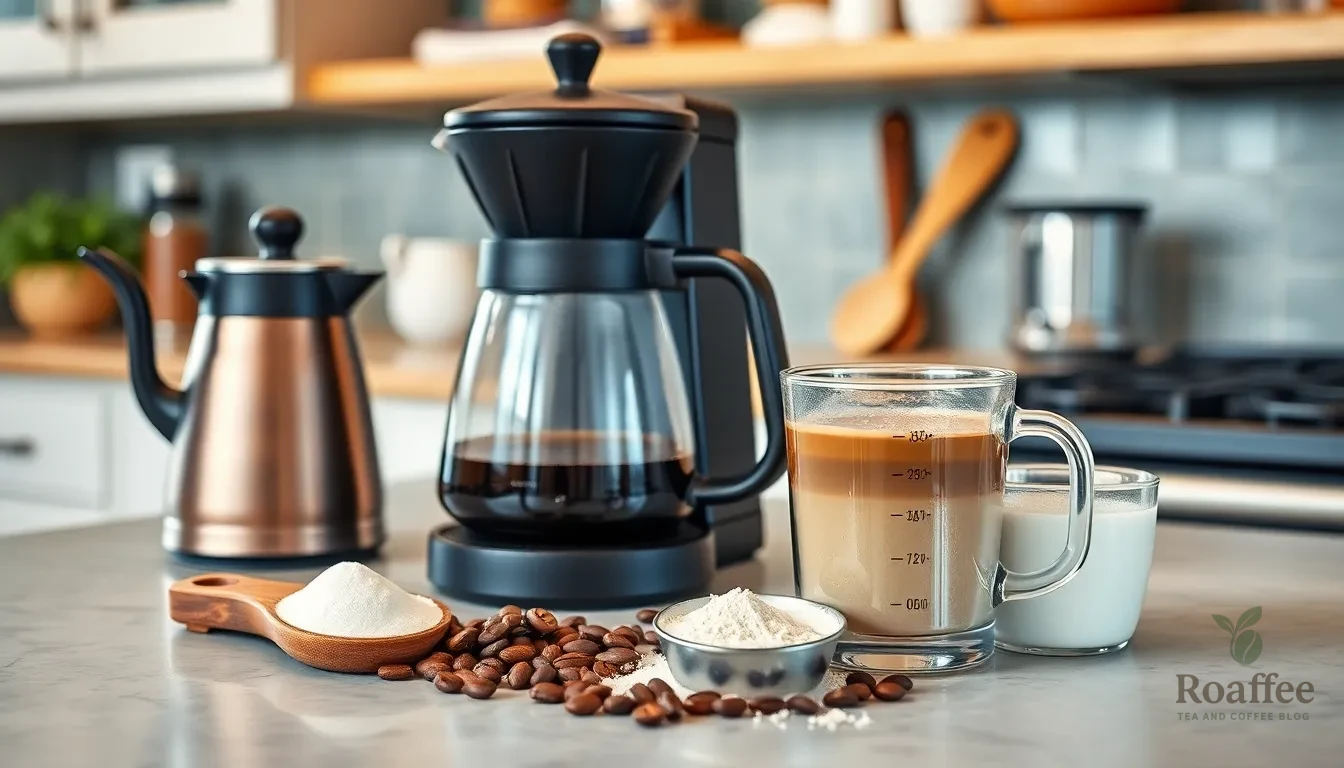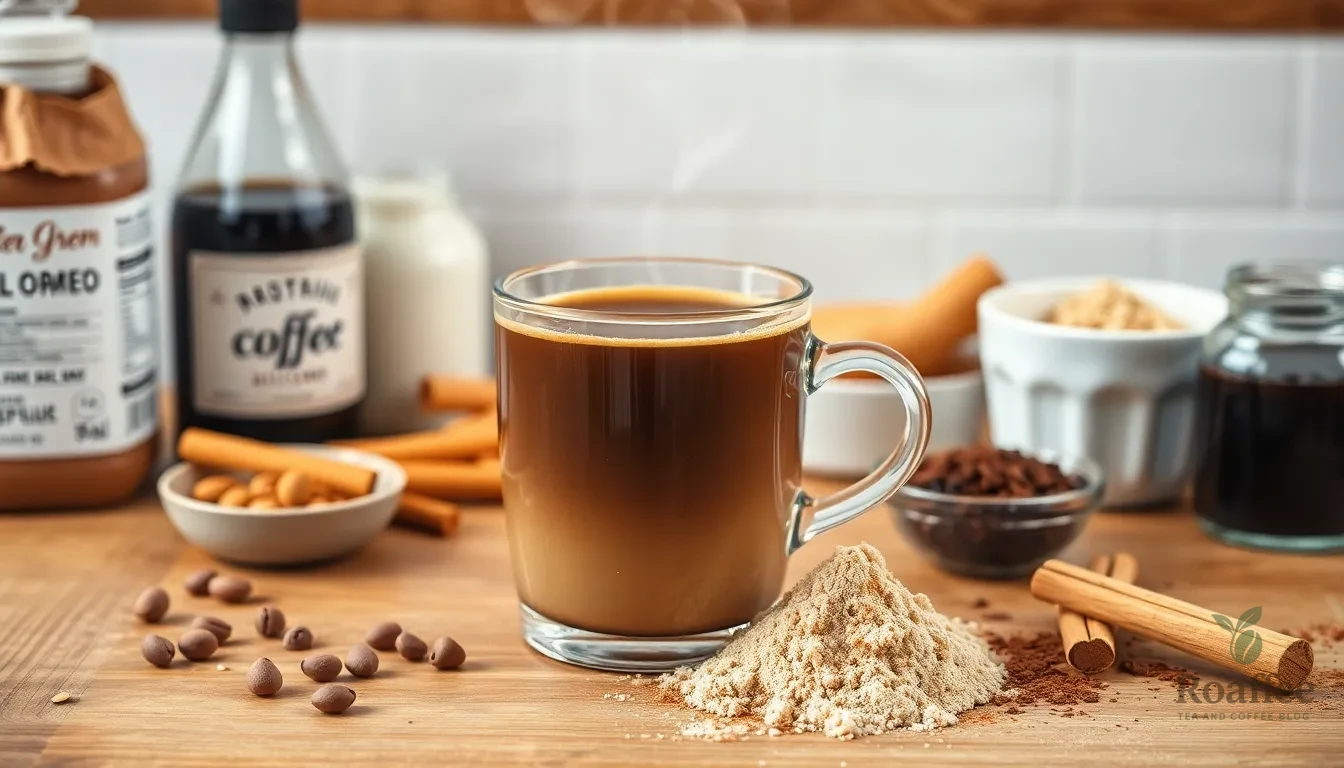We all love our morning coffee ritual but what if we told you there’s a way to supercharge your daily cup with muscle-building protein? Protein coffee combines the energizing benefits of caffeine with the nutritional power of protein powder creating the ultimate morning fuel that keeps you satisfied and energized for hours.
This game-changing drink has become a favorite among fitness enthusiasts busy professionals and anyone looking to start their day with purpose. Instead of reaching for that mid-morning snack you’ll stay full and focused thanks to the protein’s appetite-suppressing effects. Plus it tastes absolutely incredible when you know the right techniques.
We’re about to show you exactly how to create the perfect protein coffee that won’t clump won’t taste chalky and will become your new morning obsession. Get ready to transform your coffee routine into a nutritional powerhouse that delivers both flavor and function in every sip.
What Is Protein Coffee
Protein coffee combines your favorite morning brew with protein powder to create a nutritious beverage that supports your fitness goals and daily energy needs. We blend coffee with protein powder to deliver both caffeine and essential amino acids in one convenient drink.
This beverage typically contains anywhere from 15 to 30 grams of protein per serving depending on the type and amount of protein powder used. Coffee provides the familiar caffeine boost while protein powder adds muscle-building nutrients that help maintain stable blood sugar levels throughout the morning.
The drink originated in fitness communities where athletes and gym enthusiasts sought ways to streamline their nutrition routine. We can trace its popularity to the growing trend of functional beverages that serve multiple purposes beyond basic hydration or energy.
Protein coffee works by combining the stimulating effects of caffeine with the satiating properties of protein. The caffeine provides immediate energy and mental alertness while protein helps slow digestion and provides sustained energy release. This combination prevents the typical coffee crash that occurs when caffeine levels drop.
Common protein powders used include whey, casein, plant-based options like pea or hemp protein, and collagen peptides. Each type offers different benefits and flavors that can complement various coffee profiles. Whey protein dissolves easily and provides complete amino acids while plant-based options cater to dietary restrictions and preferences.
The preparation method significantly impacts the final texture and taste of your protein coffee. We recommend exact techniques to prevent clumping and ensure smooth integration of ingredients for optimal flavor and nutritional benefits.
Benefits of Adding Protein to Your Coffee

Adding protein to your coffee transforms your morning routine into a powerful nutritional strategy that supports multiple aspects of your health and fitness goals. When we combine these two ingredients, we create a beverage that delivers benefits far beyond what either component offers alone.
Enhanced Workout Performance
Coffee provides caffeine which enhances muscle contractions and reduces fatigue during exercise. Protein supplies amino acids that help muscles recover and grow stronger after workouts. When we combine these elements, we create a drink that can significantly support physical activity, especially resistance training. The caffeine boost helps us push through challenging workouts while the protein ensures our muscles have the building blocks they need for optimal performance.
Meeting Daily Protein Requirements
Protein coffee offers a convenient solution for those who skip breakfast or want to distribute protein intake evenly throughout the day. This approach can aid muscle building and strength maintenance without requiring additional meal planning. We find this particularly beneficial for busy professionals who need to maximize their nutrition while maintaining their schedules.
Muscle Mass and Recovery Support
An added 25 to 30 grams of protein from protein powder in coffee can help preserve muscle mass and assist recovery from illness or injury. This combination also supports bone health, making it valuable for long-term wellness goals. The amino acids in protein powder work continuously to repair and build muscle tissue while the caffeine helps maintain energy levels throughout the recovery process.
Weight Management Support
Protein promotes fullness and helps with weight control when part of a balanced diet. When we add protein to our coffee, we create a more satisfying beverage that can help reduce cravings and support healthy eating patterns throughout the day. This satiety effect helps prevent overeating and supports sustainable weight management strategies.
| Benefit Category | Key Advantages |
|---|---|
| Workout Performance | Enhanced muscle contractions, reduced fatigue |
| Daily Nutrition | Convenient protein distribution, breakfast alternative |
| Muscle Health | 25-30g protein support, improved recovery |
| Weight Management | Increased fullness, appetite control |
We recommend choosing unsweetened protein powders to avoid extra sugars and being mindful of total protein consumption to prevent potential weight gain or kidney issues. This strategic combination of caffeine and protein creates a practical way to enhance exercise performance, support muscle recovery, and meet nutritional needs in one convenient beverage.
Essential Equipment and Tools

Creating the perfect protein coffee requires the right equipment to achieve smooth blending and optimal flavor extraction. We recommend gathering these essential tools before starting your protein coffee journey.
Coffee Brewing Equipment
Your coffee maker forms the foundation of great protein coffee. A drip machine provides consistent results for daily preparation while pour-over setups offer greater control over flavor extraction. Espresso machines deliver concentrated coffee that pairs exceptionally well with protein powder.
We suggest investing in a gooseneck kettle for precise pouring when using pour-over methods. This tool allows you to control water flow and temperature for optimal brewing results.
Grinding and Filtering Tools
A coffee grinder ensures freshly ground beans for maximum flavor impact. Burr grinders provide consistent particle size that enhances extraction quality. Reusable or paper filters are essential for pour-over brewing methods.
We recommend rinsing paper filters before use to eliminate any papery taste that could affect your protein coffee’s flavor profile.
Mixing and Measuring Equipment
A milk frother or blender serves as your most critical tool for combining protein powder smoothly into coffee. These devices prevent clumping and create the creamy texture that makes protein coffee enjoyable.
Measuring tools include protein powder scoops and liquid measuring cups for consistent results. We use standard coffee mugs or tall glasses depending on whether you’re preparing hot or iced versions.
Optional Enhancement Tools
Additional equipment can elevate your protein coffee experience. Milk steamers create professional-quality foam while handheld frothers offer convenient mixing options. Digital scales ensure precise measurements for consistent taste and nutritional content.
We find that having dedicated equipment specifically for protein coffee preparation streamlines the process and improves the final product quality.
Ingredients

Creating the perfect protein coffee requires carefully selecting quality ingredients that work together harmoniously. We’ve organized these essential components into three key categories to help you build your ideal protein coffee recipe.
Base Coffee Options
Hot brewed coffee serves as the foundation for most protein coffee recipes, with medium roast being the most popular choice for its balanced flavor profile. Espresso shots create a latte-style proffee that delivers intense coffee flavor and smooth texture. Cold brew coffee or iced coffee provides the perfect base for refreshing iced protein coffee variations that work especially well during warmer months.
Protein Powder Selection
Whey protein powder remains the most commonly used option, available in vanilla, chocolate, caramel, or unflavored varieties that complement coffee’s natural taste. High-quality protein powders with added prebiotics, probiotics, or fiber offer additional nutritional benefits for gut health and overall wellness. Bottled protein shakes can substitute for powder in cold proffee recipes, providing convenience for busy mornings or on-the-go preparation.
Optional Add-ins and Flavorings
Milk or milk substitutes including dairy milk, almond milk, oat milk, or soy milk help create smooth texture and creamy consistency while aiding protein powder integration. Vanilla extract or flavored syrups in both sugar-free and regular varieties enhance the overall taste profile. Cinnamon or nutmeg adds warming spice notes that complement coffee’s natural flavor. Cream or whipped cream provides richness for those seeking an indulgent texture. Oat milk ice cubes offer a clever solution for iced versions, preventing dilution while maintaining creamy consistency throughout your drink.
Instructions

Creating protein coffee requires careful preparation and proper mixing techniques to achieve the perfect balance of flavor and nutrition. Follow these detailed methods to create your ideal protein coffee using hot, iced, or blended preparation styles.
Prep Your Coffee Base
We start by brewing our coffee using the preferred method that best suits our taste preferences. Drip coffee makers, pour-over setups, French press, or cold brew systems all work exceptionally well for creating the foundation of our protein coffee.
Hot coffee requires fresh brewing and immediate use while the temperature remains optimal. Keep the coffee hot throughout the preparation process to maintain the ideal serving temperature.
Cold coffee preparation involves using cold brew concentrate or freshly brewed coffee that has been chilled completely. This method prevents the protein powder from clumping when mixed with cooler temperatures.
Preheating our mug or glass before adding hot coffee helps preserve the temperature and enhances the overall drinking experience. This optional step ensures our protein coffee stays warm longer.
Choose Your Mixing Method
Blender mixing provides the smoothest texture and prevents protein powder clumps from forming in our coffee. This method creates a frothy, well-integrated beverage that resembles a coffee shop quality drink.
Milk frother technique works effectively for both hot and iced coffee preparations. We mix the protein powder with milk first using the frother, then add the coffee for optimal blending.
Whisk or shake method offers the simplest approach for quick preparation. We combine protein powder with milk using a whisk or shaker bottle, then add the coffee and stir thoroughly.
Hot Protein Coffee Method
We begin by mixing 1 scoop of protein powder with approximately ¼ cup of milk or milk substitute using a frother or whisk. Continue mixing until the mixture becomes smooth and frothy without any visible powder clumps.
Pour 6-8 oz of hot brewed coffee or two shots of espresso over the protein mixture while stirring continuously. This gradual addition prevents the protein from cooking or separating in the hot liquid.
Steamed milk can be added for extra creaminess and a café-style experience. Vanilla or caramel protein powder flavors complement the coffee taste particularly well in hot preparations.
Iced Protein Coffee Method
We combine 1 cup of cold brew or chilled coffee with 1 scoop of protein powder and ½ cup of milk or milk substitute in a blender. Blend the mixture until completely smooth to eliminate any clumps or grainy texture.
Pour the blended mixture over ice cubes in a tall glass. Using milk-based ice cubes made from oat milk or other milk alternatives prevents dilution while maintaining consistent protein content.
Flavor enhancers such as vanilla extract or sugar-free syrup can be added according to taste preferences. These additions should be blended with the base mixture for even distribution.
Alternative preparation involves using a milk frother to mix protein powder and milk, then pouring cold coffee over the mixture and adding ice. This method works well for quick preparation without a blender.
Blended Protein Coffee Method
We blend cold coffee or cold brew concentrate with protein powder, milk or milk substitute, and ice cubes together until the mixture reaches a smoothie-like consistency. This creates a creamy, refreshing drink perfect for warm weather or post-workout recovery.
The blended method combines hydration, caffeine, and protein in one convenient beverage. This approach works exceptionally well with vanilla, chocolate, caramel, or unflavored protein powders.
Adjust the ice quantity based on desired thickness and temperature preferences. More ice creates a thicker, colder drink while less ice produces a thinner consistency.
Pro Tips for Perfect Protein Coffee

Mastering protein coffee requires attention to detail and proper technique to avoid common pitfalls. We’ve gathered expert strategies to help you create a smooth, flavorful beverage every time.
Preventing Clumping
The key to clump-free protein coffee lies in never adding protein powder directly to hot coffee. We recommend combining 3 tablespoons of protein powder with 1/4 cup of milk first before introducing any coffee. This creates a protective barrier that prevents the proteins from seizing up when they encounter heat.
Use a milk frother or blender to thoroughly mix the protein powder with milk until you achieve a smooth, frothy base. This step eliminates lumps before they form and ensures even distribution throughout your drink. Adding protein powder to milk rather than coffee reduces immediate coagulation and maintains the desired texture.
Achieving Smooth Texture
We achieve the smoothest protein coffee by whisking vigorously or using a blender to create frothy protein milk. The frother method produces excellent results, but using a blender yields the smoothest and frothiest texture for those seeking café-quality consistency.
Pour your coffee slowly over the frothy protein mixture while stirring continuously to maintain the smooth texture. For iced protein coffee, pour cold brew over the frothy protein mixture first, then add ice to preserve the creamy consistency. This method prevents the proteins from separating and maintains that luxurious mouthfeel.
Flavor Balancing
Balancing flavors in protein coffee requires strategic additions that complement rather than overpower the base ingredients. We recommend adding optional sweeteners like raw sugar, flavored syrup, or vanilla extract to mask any chalky taste from the protein powder while improving the overall flavor profile.
Coffee creamer or flavored milk alternatives such as cinnamon oat milk creamer enhance flavor without compromising texture. These additions provide richness and depth that make your protein coffee taste more like a specialty drink than a supplement. Adjust your coffee strength by using cold brew for bolder flavor or regular iced coffee for a milder taste that allows the protein powder’s natural flavors to shine through.
Variations and Flavor Combinations

Now that we’ve covered the basics of protein coffee preparation, let’s explore some delicious flavor combinations that will transform your morning routine. These popular variations use different protein powder flavors and simple additions to create café-quality drinks at home.
Vanilla Cinnamon Protein Coffee
We start with vanilla protein powder as our base for this warm and comforting variation. Add a pinch of ground cinnamon or a few drops of vanilla extract to enhance the natural sweetness. The key to achieving a latte-like texture lies in frothing the milk properly before combining it with our protein mixture.
Mix 3 tablespoons of vanilla protein powder with ¼ cup of milk in your mug. Use a milk frother or whisk to blend until smooth and frothy. Pour 6 ounces of hot brewed coffee over the mixture while stirring continuously. Top with steamed milk and dust with additional cinnamon for a bakery-inspired finish.
Chocolate Mocha Protein Coffee
Chocolate protein powder creates the perfect foundation for this rich and indulgent variation. We can also achieve similar results by adding cocoa powder to unflavored protein powder. The secret to a perfect mocha lies in warming the milk slightly before blending.
Combine 1 serving of chocolate protein powder with ¾ cup of unsweetened non-dairy milk in a small saucepan. Warm the milk gently before blending with 1 cup of strong brewed coffee or 2 espresso shots. Blend until frothy and serve immediately. This method creates a luxurious texture that rivals coffeehouse mochas.
Caramel Protein Coffee
Caramel-flavored protein powder delivers natural sweetness without added sugars for this decadent variation. We recommend adding a pinch of sea salt to enhance the caramel notes and create a sophisticated flavor profile. Both hot and iced versions work beautifully with this combination.
Use the same basic mixing method with 3 tablespoons of caramel protein powder and ¼ cup of milk. After adding your hot coffee, drizzle a small amount of sugar-free caramel syrup around the edges of the mug. The salt brings out the caramel’s complexity while the steamed milk adds creamy richness that makes this variation feel like a special treat.
Storage and Make-Ahead Tips

We recommend enjoying protein coffee fresh for the best taste and texture experience. The frothy consistency and optimal flavor profile develop when ingredients combine just before consumption.
Proper Storage Methods
Store your prepared protein mixture and coffee separately when planning ahead. This separation prevents the protein from settling and maintains the drink’s appealing frothy texture. Keep protein milk or pre-made protein shakes in the refrigerator for up to 24 hours maximum.
Pre-Mix Preparation Strategy
We suggest preparing your protein and milk mixture in advance during busy mornings. Combine 3 tablespoons of protein powder with 1/4 cup of milk and store this base mixture in an airtight container. Add your fresh coffee just before drinking to preserve both flavor and consistency.
Batch Preparation Guidelines
Prepare larger quantities of cold brew coffee ahead of time for iced protein coffee variations. Cold brew concentrates store well in the refrigerator for up to one week. Mix individual servings as needed by combining the stored coffee with fresh protein mixture.
Quality Maintenance Tips
Avoid storing fully prepared protein coffee for extended periods. The protein settles and separates from the liquid creating an unappetizing texture. Fresh preparation ensures the smooth integration we achieve through proper mixing techniques.
Make-Ahead Recommendations
We recommend preparing dry ingredient combinations in advance. Pre-measure protein powder portions in small containers or bags for quick morning preparation. This approach saves time while maintaining the fresh taste and texture that makes protein coffee enjoyable.
Nutritional Information

We find that protein coffee delivers substantial nutritional benefits that make it an excellent addition to your daily routine. A single serving of protein coffee typically provides approximately 20 grams of protein depending on the powder we choose to use. This important protein content supports muscle recovery and boosts metabolism when incorporated into an overall healthy diet.
The nutritional profile of protein coffee varies based on our ingredient selections. When we use whey protein powder with 8 ounces of brewed coffee and 1/4 cup of milk, we can expect the following nutritional breakdown:
| Nutrient | Amount per Serving |
|---|---|
| Protein | 20-25 grams |
| Calories | 150-200 |
| Carbohydrates | 5-8 grams |
| Fat | 2-5 grams |
| Caffeine | 95-200 mg |
| Calcium | 100-150 mg |
We should note that these values change significantly based on the type of protein powder and milk we select. Plant-based protein powders typically provide 15-20 grams of protein per scoop while offering additional fiber and nutrients. When we choose unsweetened almond milk instead of regular milk, we reduce the calorie content by approximately 30-40 calories per serving.
Our protein coffee also delivers essential amino acids that support muscle synthesis and recovery. Whey protein contains all nine essential amino acids, making it a complete protein source. The combination of caffeine and protein creates a sustained energy release that prevents the typical coffee crash we might experience with regular coffee.
We recommend tracking the total protein intake from our protein coffee as part of our daily nutritional goals. Most adults need 0.8-1 gram of protein per kilogram of body weight, and protein coffee can contribute 25-30% of this requirement in a single serving. This makes it particularly valuable for those who struggle to meet their protein needs through whole foods alone.
The timing of our protein coffee consumption can maximize its nutritional benefits. When we drink it within 30 minutes after a workout, the protein supports muscle recovery and growth. As a morning beverage, it provides sustained energy and helps maintain stable blood sugar levels throughout the day.
Troubleshooting Common Issues

Making protein coffee can present several challenges that affect taste and texture. We’ve identified the most common problems and answers to help you create the perfect cup every time.
Protein Clumping represents the biggest challenge when making protein coffee. We recommend always pre-mixing your protein powder with milk using a frother or shaker before adding it to your coffee. This technique prevents instant clumping that occurs when protein powder meets hot liquid directly. Temperature shock causes proteins to coagulate immediately so we suggest adding your protein mixture gradually to hot coffee while stirring continuously.
Egg White Protein Issues require special attention since this powder type clumps severely in hot liquids. We advise avoiding egg white protein entirely for hot coffee preparations. Whey, pea, soy, or collagen powders work much better and dissolve more smoothly in both hot and cold beverages.
Dilution from Ice affects flavor concentration in iced protein coffee. We solve this problem by using oat milk ice cubes instead of regular ice to maintain both flavor and nutrients. These specialized ice cubes prevent watering down your drink while adding extra creaminess and nutritional value.
Temperature Management becomes crucial when combining hot coffee with protein mixtures. We prevent separation by ensuring your protein-milk mixture reaches room temperature before slowly incorporating it into hot coffee. Pour gradually while whisking to maintain smooth consistency throughout the process.
Texture Problems often stem from inadequate mixing techniques. We recommend using a milk frother for at least 30 seconds to create a smooth, frothy base before adding coffee. A blender works exceptionally well for completely smooth results, especially when making larger batches or iced variations.
Flavor Balance Issues can occur when protein powder overpowers coffee taste. We suggest starting with smaller amounts of protein powder and gradually increasing until you find your preferred balance. Adding vanilla extract or cinnamon can enhance flavor without compromising the drink’s nutritional profile.
Conclusion
We’ve covered everything you need to transform your morning coffee into a protein-packed powerhouse. From selecting the right equipment and ingredients to mastering mixing techniques and troubleshooting common issues you’re now equipped to create delicious protein coffee that fits your lifestyle.
Remember that consistency comes with practice. Start with basic recipes and gradually experiment with different protein powders flavors and preparation methods until you find your perfect combination. The key is finding what works best for your taste preferences and daily routine.
Protein coffee isn’t just a trend—it’s a practical solution for busy mornings post-workout recovery and meeting your daily protein goals. Whether you prefer it hot iced or blended you now have the tools to make this nutritious beverage a seamless part of your daily routine.
Frequently Asked Questions
What is protein coffee?
Protein coffee is a nutritious beverage that combines your regular coffee with protein powder, typically containing 15-30 grams of protein per serving. This drink originated in fitness communities and has become popular among busy professionals and fitness enthusiasts who want to enhance their morning routine with added nutrition and sustained energy.
What are the main benefits of drinking protein coffee?
Protein coffee offers multiple benefits including enhanced workout performance, improved muscle recovery, and better satiety that helps with weight management. It prevents the typical coffee crash by combining caffeine’s stimulating effects with protein’s satiating properties, while also helping you meet your daily protein requirements conveniently.
What type of protein powder works best in coffee?
Whey protein is the most popular choice for protein coffee due to its smooth texture and neutral flavor. However, casein and plant-based protein powders are also excellent options, each offering different benefits. Choose unsweetened varieties to better control flavor and avoid excessive sweetness in your drink.
How do I prevent protein powder from clumping in my coffee?
To prevent clumping, mix protein powder with milk or a small amount of liquid before adding hot coffee. Use a milk frother, blender, or whisk to ensure smooth integration. Avoid adding protein powder directly to very hot coffee, as extreme temperatures can cause the protein to separate and clump.
When is the best time to drink protein coffee?
The optimal times are post-workout for muscle recovery or in the morning for sustained energy and stable blood sugar levels. Protein coffee works particularly well as a breakfast replacement or when you need to distribute protein intake throughout the day to meet your nutritional goals.
How should I store protein coffee?
Protein coffee is best enjoyed fresh for optimal taste and texture. For make-ahead preparation, store protein powder mixed with milk separately from coffee in an airtight container. Add fresh coffee just before consumption to maintain the drink’s frothy consistency and prevent flavor degradation.
Can protein coffee help with weight management?
Yes, protein coffee can support weight management through its satiety effects. The protein content promotes fullness and reduces cravings throughout the day, while the combination of caffeine and protein helps maintain stable energy levels without the typical sugar crashes associated with regular coffee drinks.
What equipment do I need to make protein coffee?
Essential equipment includes coffee brewing equipment (drip machine, pour-over, or espresso machine), a mixing tool (milk frother, blender, or whisk), and measuring tools. Optional enhancements include a gooseneck kettle for precise pouring, coffee grinder for fresh beans, and digital scales for accurate measurements.






































